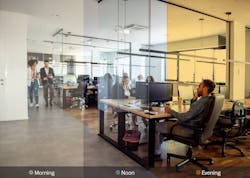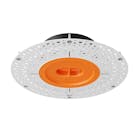CP Electronics, a brand of Legrand, launches Circadian Lighting Control as part of its enhanced RAPID lighting control system. RAPID is a comprehensive fully addressable network system that combines the very latest technology, modular mechanics and an easy-to-use graphical interface. Circadian Lighting Control falls under the category of human centric lighting, which is defined as lighting devoted to enhancing human performance, comfort, health and wellbeing.
Light is one of the biggest influences on our circadian rhythm, the natural sleep/wake cycles of the human body. It is now accepted that strategically designed lighting systems have the power to affect both our visual and non-visual systems and that electric light can impact circadian rhythm. The concept of circadian lighting follows that of the human circadian rhythm, a 24-hour internal clock. The area of the brain called the hypothalamus controls each person’s circadian rhythm by receiving signals from the eyes that report when it’s daytime and night time. The hypothalamus, in turn, controls the amount of melatonin released to correlate sleepiness with darkness and alertness with lightness.
CP Electronics’ RAPID Circadian Lighting Control uses DALI protocol to control the light fixtures based on time events that control the brightness and colour temperature throughout the day. Warmer colour temperature scenes are generally understood to offer a more casual feel whilst cooler brighter lighting can boost alertness. The overall desired influence of the colour temperature of the light is likely to be different depending on the application, and likely to change utilising the latest discoveries from the continuing research of the benefits of human centric lighting. Whether it be a static scene, a flowing change or even a repeating day to night cycle, the flexibility that the RAPID lighting control system offers gives the user the power to develop as they learn.
Different facilities and different users require a variety of options, for example care homes for mental wellbeing or health recovery centres will require different cycles from an industrial or research laboratory building which may have different day/night cycles, or office environments like financial markets where high efficiency 24-hour output is required. Some facilities prefer to boost alertness in some zones whilst programming others to offer a better atmosphere in which both can co-exist in the same building. Again central control for fast response to the feedback of the occupants is crucial and this is something that standalone event controllers cannot offer.
Whilst the colour and mood are determined by the Circadian Lighting Control event scheduler, the local presence detectors can still be co-ordinated to switch off at times of no occupancy and thereby get the best results from people-friendly lighting balanced with good energy control. Interruptions to the Circadian Lighting Control system may be needed for maintenance, unexpected events or just personal preference. These interruptions can be made by using the switch input override facility. This facility allows simple overrides to the brightness and colour temperature for each lighting group within the pre-set zones.
The RAPID lighting control system benefits from an architecture of de-centralised intelligence, meaning each component will continue to operate as best it can in the event of a failure to any of the other components. If the front end software disconnected for any reason, the system will continue with its programmed Circadian Lighting Control cycle, making the system as resilient as it can be. Adjustment of the system is intuitive and convenient as it is embedded with the standard RAPID front end software. Varying control can be achieved within specifically assigned areas via scheduler units that provide circadian event control to light output groups within any lighting control module.
Human Centric Lighting is complex and still developing so there is no set formula and different set-ups work for different people. The key is to have an easy to control interface that one can adjust as one learns. An easily adjustable interface means a fast response to make changes according to the feedback of the occupants, which is key to the success of human centric lighting control.
For more information on CP Electronics’ Circadian Control solution visit https://www.cpelectronics.co.uk/knowledge-hub/circadian-lighting-control.
Contact:
CP Electronics





